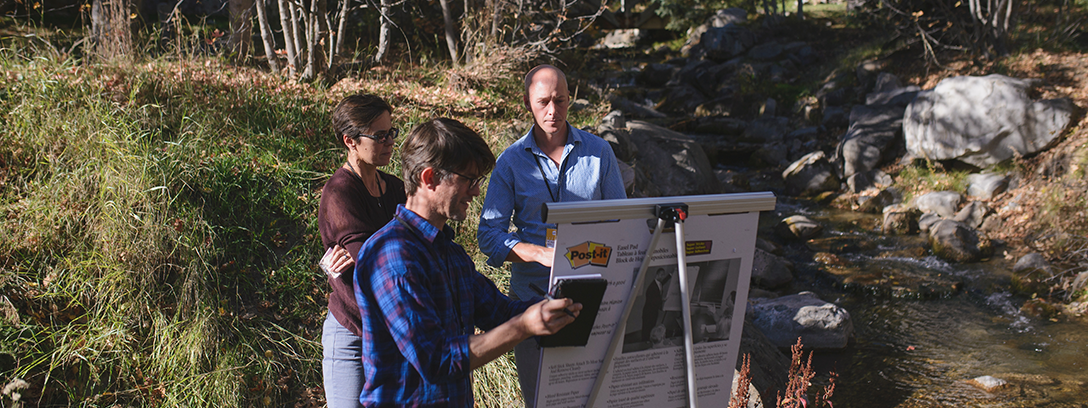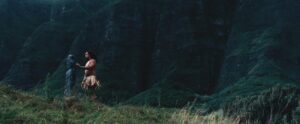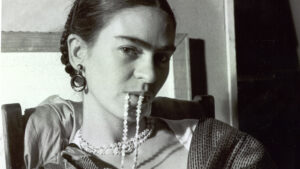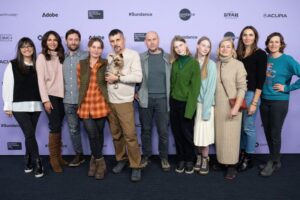(L-R) Filmmaker Leah Mahan and social entrepreneuers Garth Cripps and Alasdair Harris.
Three-and-a-half days in the mountains of Utah exploring big ideas with documentary filmmakers and change-makers I deeply respect. What could be better?
I was there as a Storytelling Fellow at the Sundance Institute | Skoll Foundation Stories of Change Convening, a three-day immersive storytelling workshop focused on introducing Skoll Foundation-Awarded Social Entrepreneurs (SASEs) to effective storytelling strategies. This was my introduction to the program, but I soon realized this moment was giving shape and definition to something I have been engaged with since my first film. The difference this time was that a process that usually begins with an independent filmmaker’s interest in a compelling story — and requires establishing a trusting relationship with the people involved — was flipped on its head.
There were four creative teams working at the Lab to develop stories addressing solutions to urgent social issues. Each team was centered on the work of a social entrepreneur whose visionary leadership had been recognized by the Skoll Foundation. The goal was to work with those change-makers to develop a story that would advance their mission. The medium was up for grabs. Three Storytelling Fellows come from documentary film and a fourth team from the world of interactive storytelling.
The Sundance team paired me up with Alasdair Harris of Blue Ventures and his colleague Garth Cripps. The organization has been working in Madagascar to restore depleted fisheries and has been successful in promoting community-based ocean stewardship. The model requires fishermen who are struggling to feed their families to stop fishing in a protected area for several months or more. It is difficult to introduce the model because of the short-term sacrifice required in communities that are already experiencing great hardship, but the idea has spread through interpersonal exchanges. Once a community tries it, the harvest is inspiring proof of its value and the model spreads like wildfire to neighboring communities. Now the organization aims to bring this model to other countries, including Vietnam and Cambodia, using film as an outreach tool.
The match made sense because my Sundance-supported documentary Come Hell or High Water: The Battle for Turkey Creek is about one man’s struggle to protect his community’s threatened culture and ecology, and my films about the Dudley Street Neighborhood Initiative are about neighborhood revitalization through grassroots leadership and community control of land.
The Convening is structured around a series of presentations and storytelling challenges. The Storytelling Fellows, Tabitha Jackson (director of the Sundance Institute Documentary Film Program), and invited artists gave presentations about different aspects of nonfiction storytelling and the Social Entrepreneurs made several presentations about their evolving story idea, culminating in a final presentation.
When Alasdair gave the initial presentation about Blue Ventures, I was struck by his confidence as a speaker, the incredibly beautiful imagery of Madagascar (photographed by Garth Cripps) and his use of scientific and economic paradigms to describe the organization’s successful model. He spoke about investment, catalysts, scale and dividends.

Over the next two days we worked together on several storytelling challenges to develop what became an idea for a short documentary focusing on the experience of one fishing family. At the final presentation, Alasdair narrated the story, which was illustrated with Garth’s photographs. He began with an opening scene on the beach, with a young woman saying goodbye to her husband who is setting off on a harrowing 1,000-kilometer journey in a small canoe to hunt for the sharks that were once plentiful nearby. While he makes his way to camp on a remote sand bank in the ocean, his wife struggles to feed their children with a diminished harvest of octopus and reluctantly becomes engaged with an ocean stewardship program. An elder explains that her people call themselves “children of the sea” because they descend from a fisherman and a mermaid. Their once-symbiotic relationship with the ocean has been disrupted, and now they need to protect the sea in order to reap a more plentiful harvest.
The initial presentation Alasdair gave was extremely effective for funders and supporters looking for evidence of impact, but the organization needs to reach the hearts and minds of fishermen who will be skeptical unless the reality of their lives is reflected. In addition to searching for a story that would resonate, we talked about how the film would reach communities, including translation into local languages, outdoor screenings in fishing villages on boat sails (a strategy Blue Ventures has used) and post-screening discussions with fishermen who could speak from first-hand experience.
Reflecting on our conversations, I thought about the ways the artists and social entrepreneurs had to get out of their comfort zones in order to understand each other. Alasdair came to his work because of a deep connection to a particular place and set of circumstances, but the success of that work depends on his ability to extrapolate from the particular, replicate models and bring programs to scale.
As a nonfiction storyteller, I work to find the teachable moments when I can see the vast systems that shape our lives crystalized into tangible human experience. So while he’s going macro, I’m going micro. Bringing those two ways of thinking together is not easy, but it makes an enormous amount of sense.
About the Author
Leah Mahan, producer/director and cinematographer, recently completed COME HELL OR HIGH WATER: The Battle for Turkey Creek, a documentary about a coastal Mississippi community settled by emancipated slaves that is threatened by urban sprawl and environmental contamination. In 2011 she attended the Sundance Institute Documentary Editing and Story Lab as a Fellow working on a rough cut of the film.




